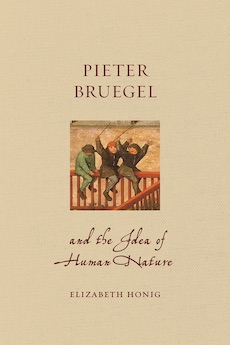By Svetlana Alpers
The book is a delight in many ways. First, it is so well written: the explication is clear, and it is rich. The compact format comes easy to the hands. It is surprising how much of the detail in Pieter Bruegel’s works is visible despite the small size of the images. It will rekindle your interest if you already know Bruegel, and it will draw you to him if you don’t.
Elizabeth Alice Honig’s text offers us a sturdy platform on which to stand and from which to view Bruegel. At the center of the contemporary idea of human nature referred to in the title is the thought and writing of Erasmus of Rotterdam. He died in 1536 when Bruegel was still a child. Bruegel’s peasants, who in the past were seen as markers of sin or simply as real life observed, are here subjects of thought. Erasmus’ concerns with human self-searching, seeking, and knowing, acknowledging the challenge which violence presents to human behavior, and his curiosity and delight in the life of ordinary people as present in popular proverbs all have resonance with and in Bruegel.
And there is more. For example, Bruegel’s famous trip to Italy and back is accompanied by commentary on Ortelius, the great mapmaker who was his contemporary. And the account of his great painting of the festive disputation between Carnival and Lent guides us from the occasion itself to Juan Luis Vives’ On Helping the Poor to the nature and notions of leprosy and contemporary attitudes towards the deformed or disabled. All of this while Honig addresses how physiognomies, painted and in life, were seen and read at the time.
While concurrent with the thought of the time, Bruegel’s paintings are themselves matters of paint. They outdistance what people could have said about them at the collector’s dinner party outside of Antwerp with which Honig cleverly opens the book. Perhaps there is more to see than is seen here. How does one deal with the striking and odd juxtaposition of two boys from Children’s Games, their arms raised in play next to the dejected (?) boy bent over beside them that is extracted and made central for the book’s cover? Where is the great and astonishing purple iris Bruegel plants just before his blind leading the blind into a ditch?
Honig is disarmingly upbeat when she asks: When do we stop joining the fun and laughing with pleasure and begin distancing ourselves as more rational and respectable beings? But is that really a choice Bruegel gives us? I don’t think Bruegel offers us that wiggle room. His comedy is deeper and more searching than that. No one escapes or grows out of human behavior as he shows it.
It is striking how disparate and passionate writing about Bruegel was within the 20th century. Leading scholars and critics were drawn to the oddity and ambiguity of his work. The formal oddity—seeing Bruegel in terms of blots or macchia of color and emphasizing his estrangement from his (on this account) dehumanized depiction of human beings—was the subject of the eventually fascist temperament of the Viennese art historian Hans Sedlmayr. And the ambiguity—moving in close to puzzle in phenomenological terms about the situation and relationship of every figure—was the subject of a complex account given of Childrens’ Games by Edward Snow. The sturdy platform offered in this book is a solid way to avoid such passions.
If you live near a museum that has any work by Pieter Bruegel, go now. Look long and close, and see for yourself
Reviewer Svetlana Alpers, an artist, critic, and renowned art historian, is professor emerita of the history of art at the University of California, Berkeley and a visiting scholar in the Department of Fine Arts at New York University.




